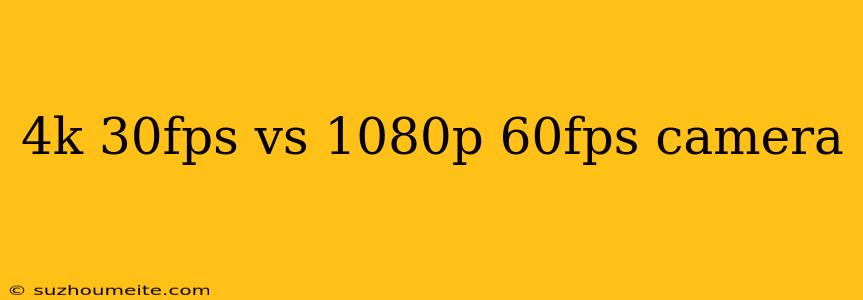4K 30fps vs 1080p 60fps Camera: Which One is Better?
When it comes to capturing high-quality video, there are two popular options: 4K 30fps and 1080p 60fps. Both have their own strengths and weaknesses, and the right choice for you depends on your specific needs and preferences. In this article, we'll break down the key differences between these two options and help you decide which one is best for you.
Resolution: 4K vs 1080p
The first and most obvious difference between 4K 30fps and 1080p 60fps is the resolution. 4K (3840 x 2160 pixels) offers a much higher resolution than 1080p (1920 x 1080 pixels). This means that 4K footage will be much more detailed and crisp, making it ideal for applications where image quality is paramount, such as cinematic productions, photography, and professional filmmaking.
On the other hand, 1080p is still a high-definition resolution, but it's not as sharp as 4K. However, it's still a great option for many use cases, such as YouTube videos, social media content, and personal projects.
Frame Rate: 30fps vs 60fps
The frame rate, measured in frames per second (fps), refers to how smoothly the video plays. 30fps is the standard frame rate for most video content, including TV shows and movies. It provides a smooth and natural-looking motion, but it may not be ideal for fast-paced content or applications where motion blur is a concern.
60fps, on the other hand, offers a much smoother and more responsive video experience. This is especially important for content that involves fast motion, such as sports, action scenes, or video games. 60fps can also reduce motion blur and make the video feel more lifelike.
Bitrate and File Size
Another key difference between 4K 30fps and 1080p 60fps is the bitrate and file size. 4K 30fps typically requires a higher bitrate to maintain its high resolution, which results in larger file sizes. This can make it more difficult to store and transfer the footage, especially for those with limited storage space or slower internet connections.
1080p 60fps, on the other hand, requires a lower bitrate, resulting in smaller file sizes. This makes it more convenient for sharing and uploading to online platforms.
When to Choose 4K 30fps
- You need extremely high image quality for cinematic productions, photography, or professional filmmaking.
- You want to future-proof your footage for 4K TVs and devices.
- You're willing to compromise on frame rate for higher resolution.
When to Choose 1080p 60fps
- You need a high frame rate for fast-paced content, such as sports, action scenes, or video games.
- You want to prioritize smooth motion over high resolution.
- You need to share your footage online and want smaller file sizes.
Conclusion
Ultimately, the choice between 4K 30fps and 1080p 60fps depends on your specific needs and priorities. If you need high image quality and are willing to compromise on frame rate, 4K 30fps may be the better choice. However, if you prioritize smooth motion and don't need the highest resolution, 1080p 60fps is a great option.
Remember to consider your equipment, software, and storage limitations when making your decision. Whichever option you choose, you'll be able to capture high-quality video that meets your needs and exceeds your expectations.
